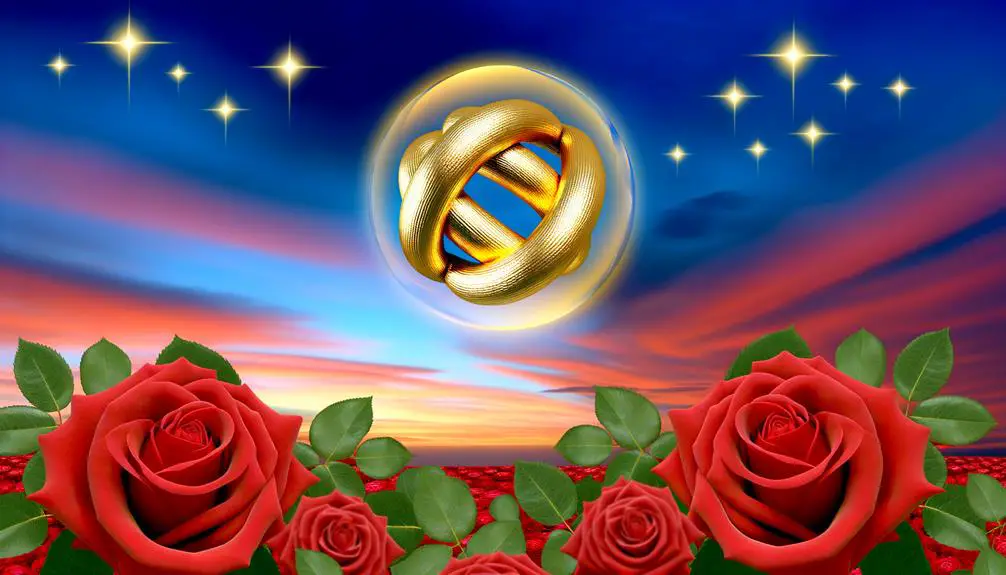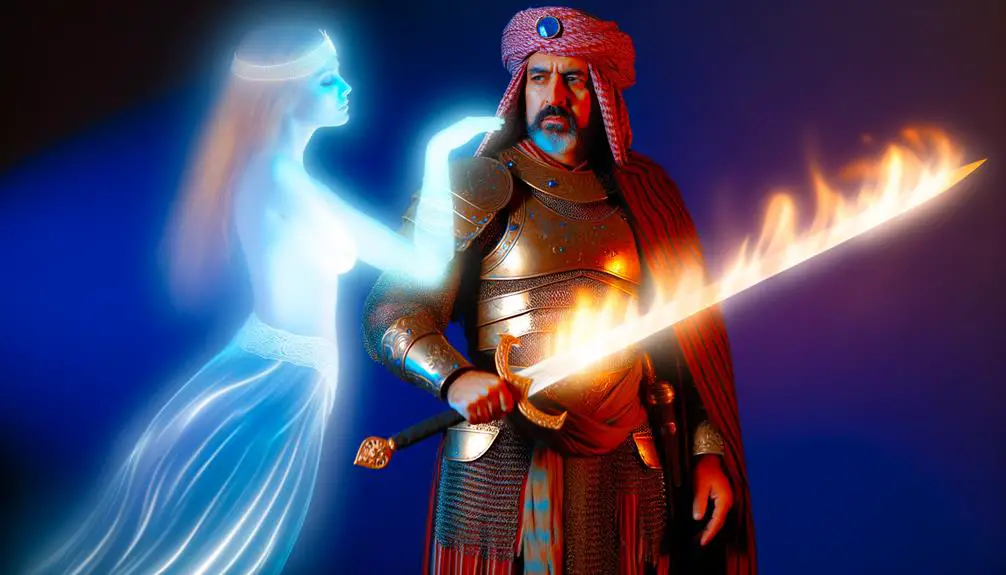Timeless Symbols of Strength and Love
Symbols of strength and love are deeply ingrained in cultural narratives, fostering resilience and connection. The lion exemplifies unwavering courage, confronting life's challenges head-on.
The heart signifies boundless love and emotional depth, transcending cultural barriers. An anchor symbolizes steadfastness, grounding us in turbulent times, while the oak tree represents enduring strength and longevity.
The phoenix embodies renewal and hope, showcasing transformation through adversity. Finally, the knot illustrates unbreakable bonds, emphasizing trust and unity.
These rich symbols guide us through life's journey, offering profound insights and meaning. Discover more about how these symbols can inspire and uplift.

Key Takeaways
- The lion symbolizes both strength and intrinsic bravery, confronting challenges head-on.
- The heart universally represents love, connection, and emotional depth across cultures.
- The oak tree signifies endurance, strength, stability, and growth through harsh conditions.
- The anchor epitomizes unwavering stability, faith, and hope, providing security and resilience.
- Motherhood offers a protective embrace, combining emotional support, physical safety, and unconditional love.
The Lion's Courage

The lion's courage serves as a profound symbol of resilience and unwavering strength in the face of adversity. This majestic animal embodies an intrinsic bravery that resonates deeply within the human spirit. Its ability to confront challenges head-on, regardless of the odds, offers a compelling metaphor for our own struggles.
Much like the lion, individuals often find themselves traversing difficult terrains in life, seeking the fortitude to persevere. By drawing inspiration from the lion's fearless demeanor, one can uncover hidden reserves of inner strength and tenacity. This emblem of courage encourages us to face our fears with a bold heart, fostering a sense of empowerment and hope in times of uncertainty and hardship.
The Heart's Universality
The heart is a powerful universal symbol that resonates with people across different cultures. This is seen in various interpretations found in global art and language. From ancient hieroglyphics to modern emojis, the heart encapsulates affection, empathy, and human connection.
Cultural Interpretations of Heart
Across diverse cultures, the heart symbolizes a profound connection that transcends linguistic and geographical boundaries. In Western traditions, it is often seen as the epicenter of love and affection, encapsulated in expressions like 'giving your heart.'
In contrast, Eastern philosophies, such as in Chinese culture, view the heart as the seat of wisdom and emotional intelligence. Similarly, Indigenous cultures frequently regard the heart as a bridge between the spiritual and physical domains.
This universal symbol serves as a reminder that, despite our differences, shared human experiences of love, compassion, and resilience unite us. Recognizing these cultural interpretations fosters mutual respect and deeper understanding, celebrating the heart as a universal emblem of our shared humanity.
Heart in Global Art
Throughout history, artists from various cultures have utilized the heart as a profound symbol to convey themes of love, strength, and unity in their works. This universal motif transcends geographical boundaries and cultural differences, providing a shared language that resonates deeply with human emotions.
In ancient Egyptian art, the heart was depicted as the center of thought and emotion, while in medieval Europe, it was often showcased in religious iconography to signify divine love and human compassion. Similarly, contemporary artists across the globe continue to explore the heart as a powerful symbol, often infusing it with personal and societal narratives.
Through these artistic expressions, the heart remains a timeless emblem that unites humanity in its collective experience of love and resilience.
Heart Symbols in Language
In addition to its prominent place in art, the heart has permeated language as a universal symbol, representing concepts of love, courage, and emotional depth across diverse cultures.
Phrases such as 'heartfelt gratitude,' 'heart of gold,' and 'broken heart' convey powerful sentiments that resonate deeply within us. The heart transcends linguistic barriers, encapsulating human experiences in a way that is immediately understood, regardless of one's native tongue.
This ubiquity fosters a shared emotional lexicon, allowing us to connect and empathize with others. Besides, the heart's linguistic symbolism underscores its role in unifying humanity through shared emotional experiences, reminding us of our intrinsic capacity for compassion and resilience.
Understanding these symbols enriches our communication, deepening our connections with one another.
Motherhood's Protective Embrace

A mother's protective embrace serves as an unwavering shield, offering both comfort and security amidst life's uncertainties. This intrinsic form of protection is not just physical but also emotional, providing a sanctuary for her child to retreat to in times of need.
Mothers instinctively create an environment where fears are eased and courage is nurtured, reinforcing their child's resilience.
- Emotional Support: A mother's embrace offers a safe space for expressing emotions without fear of judgment.
- Physical Safety: Her protective arms serve as a barrier against physical harm and environmental dangers.
- Psychological Assurance: Through her comforting touch, a mother instills confidence and a sense of belonging.
These elements collectively form the essence of a mother's protective embrace, embodying strength, love, and unwavering support.
The Anchor's Stability
The anchor has long been a symbol of stability, offering a steadfast presence in the midst of turbulent times. Its historical significance, rooted in nautical traditions, underscores its role in providing security and grounding.
Exploring its symbolic meaning further highlights the anchor's enduring influence, both in maritime contexts and as a broader emblem of resilience and unwavering support.
Historical Significance
Throughout history, the anchor has symbolized stability and resilience, offering a sense of unwavering support in turbulent times. This emblem has been a beacon of hope and fortitude, deeply rooted in various cultures and epochs. Its historical significance is multi-faceted:
- Ancient Maritime Use: Anchors were pivotal in ancient seafaring, providing ships with stability amidst unpredictable waters.
- Early Christian Symbolism: Early Christians adopted the anchor as a secret symbol of faith and hope during periods of persecution.
- Cultural Representation: In literature and art, anchors have often represented steadfastness and the safe return home.
Understanding the anchor's historical significance underscores its enduring role as a metaphor for stability and resilience, resonating through centuries of human experience.
Symbolic Meaning
Building on its rich historical significance, the anchor continues to epitomize unwavering stability and steadfastness in modern symbolism.
As a timeless emblem, it resonates deeply with individuals seeking constancy amid life's turbulence. The anchor represents a grounding force, offering a sense of security and resilience. This potent symbol is often embraced during challenging times, providing comfort and a reminder of one's inner strength and ability to endure.
Nautical Influence
Anchors have long been essential to maritime navigation, symbolizing stability and safety amidst the unpredictable nature of the sea. This singular object, often understated, holds profound significance for sailors and maritime enthusiasts alike. An anchor does more than merely hold a vessel in place; it represents resilience and steadfastness.
- Security in Storms: In turbulent waters, the anchor's grip provides a lifeline, offering comfort and assurance.
- Navigational Aid: Beyond its physical function, it symbolizes guidance, helping seafarers find their way.
- Historical Significance: Anchors have been revered through history, representing hope and salvation.
Understanding the anchor's role in nautical contexts allows us to appreciate its symbolism in broader life, embodying the strength and love that keeps us grounded amid life's tempests.
The Oak Tree's Endurance

The oak tree's remarkable endurance stands as a proof of its resilience and unwavering strength. This majestic tree has the ability to withstand harsh weather conditions, including powerful storms and prolonged droughts, demonstrating an unwavering tenacity that mirrors the human spirit.
Its deep roots anchor it firmly to the ground, while its broad branches reach skyward, symbolizing growth and stability. The oak's longevity, often spanning centuries, provides a sense of continuity and assurance, reminding us that strength and endurance go hand in hand.
In times of personal struggle, the oak tree serves as a poignant metaphor for enduring life's challenges with grace and fortitude. Its presence, both commanding and reassuring, inspires us to remain steadfast and resilient in our own lives.
The Phoenix's Rebirth
Amidst the ashes of devastation, the phoenix's rebirth serves as a powerful symbol of renewal, transformation, and the enduring capacity for overcoming adversity. This mythical creature's cycle of death and resurrection provides a poignant reminder that even in moments of profound loss, there is potential for profound growth and rejuvenation. The phoenix embodies the spirit of rising above challenges, emerging stronger and more resilient.
Consider the following vivid imagery:
- Rising from Ashes: The phoenix ascends from the remnants of its former self, encapsulating hope and new beginnings.
- Flames of Transformation: The fire symbolizes the necessary trials that forge strength and character.
- Eternal Cycle: The continuous loop of death and rebirth signifies perpetual renewal and the promise of enduring resilience.
Understanding these facets offers solace and inspiration during times of personal and collective hardship.
The Knot's Unbreakable Bond

Just as the phoenix's renewal teaches us about resilience, the knot symbolizes the enduring strength of bonds that withstand the tests of time and adversity. The knot, through its intricate intertwining, represents how relationships, whether personal or professional, can be fortified through mutual support and understanding. The unbreakable bond of the knot highlights the importance of consistency, trust, and shared goals.
| Element | Symbolism | Impact |
|---|---|---|
| Intertwining | Unity | Strengthens connections |
| Complexity | Depth of relationship | Fosters deeper understanding |
| Tightness | Security | Promotes trust and reliability |
| Endurance | Longevity | Secures lasting bonds |
| Flexibility | Adaptability | Enables growth and resilience |
Understanding these elements allows us to nurture relationships that thrive despite challenges, embodying the true essence of unbreakable bonds.
The Eagle's Vision
Eagle's vision, characterized by keen focus and far-reaching clarity, offers a profound metaphor for the foresight and perspective needed to navigate life's complexities. This extraordinary sight empowers us to see beyond the immediate, fostering a deeper understanding of our path and purpose. By embracing the eagle's vision, we can cultivate a mindset that transcends obstacles and embraces opportunities with wisdom and grace.
Consider the following aspects of the eagle's vision:
- Precision: The ability to hone in on details that others might overlook.
- Distance: Seeing the broader picture without losing sight of immediate goals.
- Adaptability: Adjusting focus quickly to changing circumstances.
These attributes encourage us to remain resilient and perceptive, guiding our journey with unwavering clarity and inner strength.
The Warrior's Valor

Embodying the same clarity and strength as the eagle's vision, the warrior's valor represents an unwavering courage and determination in the face of adversity. This valor is not merely physical; it is an inner fortitude that fuels resilience and perseverance.
A warrior's courage is deeply rooted in love—love for their community, their values, and their mission. This profound connection transforms challenges into opportunities for growth, forging a path of integrity and honor.
Understanding the warrior's valor helps us appreciate the strength that emerges from vulnerability and the bravery required to stand steadfast against the unknown. In embracing this valor, we recognize the power of courage intertwined with compassion, a attestation to the enduring spirit of humanity.
Conclusion
In sum, symbols of strength and love encompass a diverse range of representations, from the lion's courage to the phoenix's rebirth. Some contend that the subjective nature of symbols diminishes their universal applicability.
However, these symbols resonate across cultures and epochs precisely because they encapsulate fundamental human experiences. Embracing these symbols fosters a deeper understanding and appreciation of the virtues they embody, thereby enriching collective human consciousness and reinforcing shared values.






